
Throughout Module B and the exploration of the Technology Based Learning Experiences I have come to understand that design framework requires a particular awareness not only of the desired outcome for student learning but for teachers as well. Each of the design frameworks explored focused on the role of the student in the learning process as well as the role of the teacher in the teaching design, as one cannot occur without the other. When I reflect upon my own teaching style, I often look to see how the learning engagements I have chosen provide opportunities for students to become, remain, and sustain motivation and curiosity.
Within the IB framework of inquiry based learning, I saw many parallels with the TELEs explored, drawing upon collaboration, inquiry based projects, and student centred learning. Anchored Instruction, provides students with opportunities to explore videos that are exciting, challenging, and interesting. Students in my own classroom would love the various challenges presented. Benefits of this design framework provide a differentiated approach where students of all abilities can find success, but more importantly can personally challenge themselves to excel through problem solving and critical thinking. Within my math and science classes, I would like to see a partnership between senior grades and intermediate classes creating videos together to be used in future classes (a possibility in a K-12 school). Real-world videos, as an example of visible thinking routines, leaves an everlasting memory for students to access this knowledge construction in the future.
The WISE framework also drew parallels with the IB inquiry based model of instruction. By providing opportunities for students to express their prior knowledge, myself as a teacher need to ensure that these learning engagements are not merely for show, but that students take time to complete, and that the teacher returns to this activity for reflection. Students learn best when they review what they have done, even if it is a KWL chart! Students construction of understanding and meaning was very much possible through the WISE project, something I would consider integrating into my own classes in science in the future. I especially found the use of technology critical for the action component in the inquiry cycle, as students can take meaningful action based on what others have done, and what motivates them.
The Learning for Understanding design framework provides students an opportunity to construct meaning along the way. This framework was one of my favourite as it took into account the fact that students learn best when they can communicate and collaborate with peers and teachers. When students are motivated and encouraged to take-risks in their learning by making predictions and thinking critically the best learning occurs. Again, this model supports the importance of teaching and learning from both the student and teacher perspective. In my own science and math classes I would continue to consider using technology that allows for opportunities of exploration as well as interaction with experts.
Finally, the T-Gem model also fits nicely with the IB model of inquiry based learning. Here both the role of the student and teacher are critical for the success of student understanding. Again, students play an active role in their journey towards understanding, and can many times offer insight for the teacher. In my own science classes I would continue to design learning engagements that involve this cycle of generate, evaluate and modify.
Reviewing each TELE allowed me to synthesize my own journey throughout this module by providing me with an opportunity to reflect upon my original knowledge, areas I wondered about, and now what I have learned throughout the process. This simple KWL learning engagement allowed me to meaningfully construct knowledge while reviewing what I had explored. Therefore, it is critical that teachers design learning opportunities that are motivating and engaging for their students. In today’s classroom, collaboration, critical thinking, creativity, and communication are the cornerstone of 21st century learning and very possible when teachers find ways to integrate technology in meaningful ways.
Included is my visual synthesis of each TELE explored.
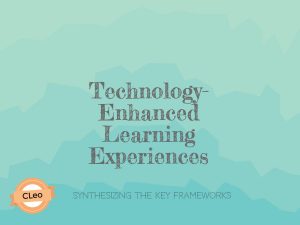
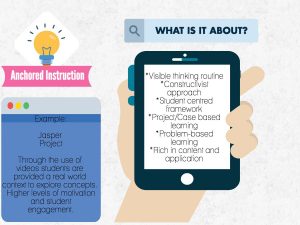
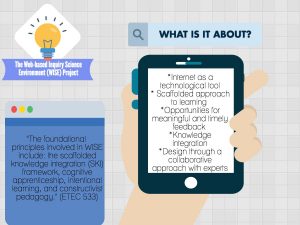
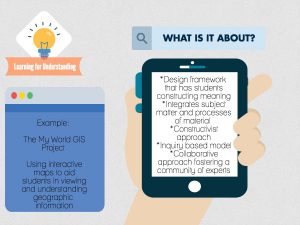
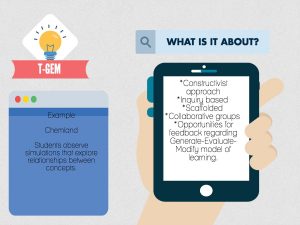
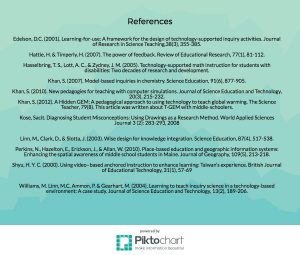
References
Edelson, D.C. (2001). Learning-for-use: A framework for the design of technology-supported inquiry activities. Journal of Research in Science Teaching,38(3), 355-385.
Hattie, H. & Timperly, H. (2007). The power of feedback. Review of Educational Research, 77(1), 81-112.
Hasselbring, T. S., Lott, A. C., & Zydney, J. M. (2005). Technology-supported math instruction for students with disabilities: Two decades of research and development.
Khan, S. (2007). Model-based inquiries in chemistry. Science Education, 91(6), 877-905.
Khan, S. (2010). New pedagogies for teaching with computer simulations. Journal of Science Education and Technology, 20(3), 215-232.
Khan, S. (2012). A Hidden GEM: A pedagogical approach to using technology to teach global warming. The Science Teacher, 79(8). This article was written about T-GEM with middle-schoolers.
Kose, Sacit. Diagnosing Student Misconceptions: Using Drawings as a Research Method. World Applied Sciences Journal 3 (2): 283-293, 2008
Linn, M., Clark, D., & Slotta, J. (2003). Wise design for knowledge integration. Science Education, 87(4), 517-538.
Perkins, N., Hazelton, E., Erickson, J., & Allan, W. (2010). Place-based education and geographic information systems: Enhancing the spatial awareness of middle school students in Maine. Journal of Geography, 109(5), 213-218.
Shyu, H. Y. C. (2000). Using video‐based anchored instruction to enhance learning: Taiwan’s experience. British Journal of Educational Technology, 31(1), 57-69
Williams, M. Linn, M.C. Ammon, P. & Gearhart, M. (2004). Learning to teach inquiry science in a technology-based environment: A case study. Journal of Science Education and Technology, 13(2), 189-206.
Hi Cristina,
This is a well written synthesis on the four TELEs that we’ve examined in recent weeks. One of the aspects that stood out for me was the importance of reflecting and modifying within the frameworks of each TELE. The notion of revisiting, revising, and modifying throughout the learning process is of critical and fundamental importance. It seems to me that with the demands of the curriculum and the time constraints that teachers are bound by, there is sometimes a feeling that we need to push students onto their next learning experience, and the opportunities to truly reflect are missed as a result. By making reflecting and modifying a key component of the learning process, we can provide deeper learning opportunities while integrating an emphasis on the importance of feedback and collaboration. I’m curious to know if any of the four TELE frameworks stood out to you as being perhaps more relevant to your current teaching practice?
Thanks for your post,
– Allen.
Hi Cristina
I like the fact that you discussed a “partnership between senior grades and intermediate classes”. There is a Digital Media teacher in Coquitlam that partners with an elementary school teacher. The elementary students write a story and the senior students make an animation of the story.
I wonder why there is very little collaboration between elementary and high school teachers? Is it because we are all too busy doing our own thing? How would one go about setting this up? The PSA Superconference (https://www.psasuperconference.ca/) this fall might be a time to make connections.
A good next step might be in the next six months — to make a connection with another teacher — to work on a project together.
Christopher
Hi Christopher and Allen,
Thank you for the link. This will definitely be something I will pursue this fall as I am fortunate to work in a continuing K-12 school. Moving to a new grade (1) will also be an interesting opportunity for students to collaborate with intermediate students.
I agree that more emphasis should on collaborating with teachers and forming a strong network that is connected to meet the goals of teaching, especially with the new curriculum in BC. By role modelling working with fellow teachers, students can see first hand the value of building relationships.
Allen–I really liked the anchored instruction which provides a scaffolded approach and provides opportunities for collaboration and students to describe their thinking. Too often I hear
Fellow
Teachers telling kids the answer and not allowing them to arrive at the solution with understanding. Especially in math when I’ve hear “it’s about the right answer” this is a scary statement for an educator to make as it should be about critical thinking and problem solving that occurs to reach the answer. Innovation won’t occur if we stifle creativity and worry about right and wrong.
Thanks for your comments!
Cristina